Time has told me
You’re a rare rare find
A troubled cure
For a troubled mind.
And time has told me
Not to ask for more
Someday our ocean
Will find its shore.
So I`ll leave the ways that are making me be
What I really don’t want to be
Leave the ways that are making me love
What I really don’t want to love.
Time has told me
You came with the dawn
A soul with no footprint
A rose with no thorn.
Your tears they tell me
There’s really no way
Of ending your troubles
With things you can say.
And time will tell you
To stay by my side
To keep on trying
’til there’s no more to hide. ( Nick Drake, Time Has Told Me )
”It is true that to the end of his life the great artist could neither spell correctly, nor write grammatical English; but then many others who presumably and professedly have received a good education, have to these two things been woefully weak…Let the dull boys and the dull girls, as they may be pronounced, take heart of grace. Their dullness in one direction may be but the reverse side of genius in another.”
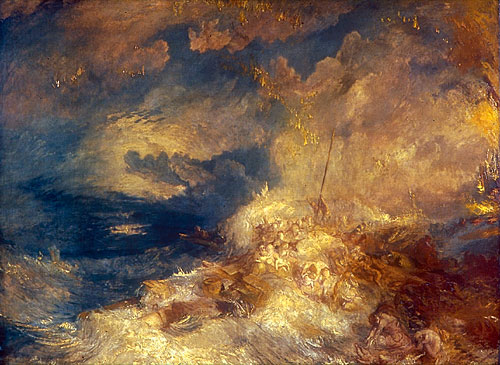
Turner. Disaster at Sea.1835. Schama: ''He was, once again, playing with fire, and although that 1835 picture is in a radically incomplete state, it's the skeleton of a masterpiece. Flecked with gobs of phosphorescent cinders raining down from the sky into a storm-churned sea, the huge composition was traditionally given the title "Fire at Sea." For years, it was underrated and underread as a rough sketch. It is in the National Gallery show, where visitors will find it described as "Disaster at Sea," which is right but not right enough. Fifteen years ago, the scholar Cecilia Powell recognized that the work depicted an actual calamity, or, rather, a crime: the sinking of the Amphitrite, in September, 1833. Powell made one simple, vital connection that hadn't been noticed before: the frantic figures wrapped about the broken mast and fallen spars of the rapidly sinking wreck are all women and small children. The Amphitrite was a convict ship transporting female prisoners and their infants to the penal settlement in New South Wales. ...''
In keeping with this sentiment there seems to be no argument that Turner had genius. The son of Rev. Trimmer, Turner’s eldest executor, had a special fondness for the normally taciturn artist. He probably knew him very well, for Turner at times played the surrogate father, taking him on sketching trips. Many years later Trimmer wrote: “Though not polished, he was not vulgar. In common with many men of genius, he had not a good flow of words, and when heated in argument got confused.”
Turner traveled incessantly in his twenties, looking for something that eluded him as an artist, without really knowing quite what it was, though he knew the idyllic and pastoral comforts painted by Constable left him with an intimate unease. He traveled throughout the British Isles and the Continent and all these experiences were reflected in his paintings. He had seen avalanches, and storms at sea, and he alternated paintings of the destructive forces of nature with others of traditional landscapes in which rural England was adapted to the combination of romanticism and formality that had kept the Frenchman Claude Lorrain a deity of the Academy. Turner never hesitated to challenge comparison with the old masters, and he challenged Claude on his own ground, not only on Claudian adaptations of local subjects but with hi
ical pictures on an operatic scale like the famous ”Dido Building Carthage”.But the catalyst was somehow missing. By his early forties Turner had been a professional artist for a full quarter of a century, and his preoccupation with the quality of light had been continous. The catalyst, or the fuse that lit the explosion, was his first trip to Italy, in 1819, when he was forty-four. He stayed five months.
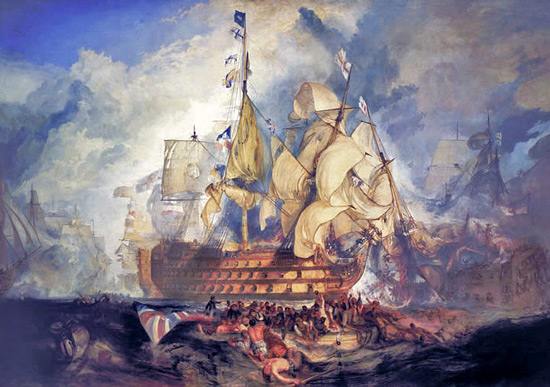
Turner. Battle of Trafalgar. ''In the case of the spectacular action painting "The Battle of Trafalgar," Turner did his homework, going to Sheerness to see the hulk of Nelson's flagship, H.M.S. Victory, and carefully sketching its splintered beams. But he threw the research away to compose, in 1806, an astounding enactment of the chaos of war at sea, using a viewpoint high up in the mizzenmast shrouds, where, although ostensibly on the British man-of-war, the beholder can as easily imagine himself in the roost of the French sharpshooter who kills Nelson. The entanglement of the ships of the line, like so many lumbering dinosaurs locked in belligerent slaughter, is described through an inchoate massing of sails, each impossible to connect to any vessel in particular.''
Turner was far beyond the stage when the Vatican, with its Raphaels and Michelangelos , and the other shrines of Renaissance art would mean much to him. He made the Italian trip to see the sights, the ruins of antiquity, and perhaps from a general curiosity and the restlessness that made him a traveler all his life. What he discovered was that there existed in this southern country a kind of light that belonged to him and his painting.
Turner had conceived of the elements in storm; water in flood, earth in avalanche, air in hurricane, and now he saw that there could be a storm in light. He saw that solid objects might be consumed in a sparkle of brilliant, shadowless radiance in a way altogether different from their soft dissolving in the cool ”mists and exhalations” of the north. As if to make the revelation complete, Vesuvius erupted and Turner hurried down to Naples with his water-color box to make firsthand acquaintance with primeval fire as a destructive natural force.
Turner’s work from now on, truly revolutionary in its increasingly rough surfaces of pure color, its sacrifice of solid form to immaterial substances, its cataclysmic subjects, increasingly puzzled and offended most critics. But Turner was invulnerable. He had already made a fortune. If nobody had bought the new pictures, it would not have made much difference, but there were assidious Turner collectors in spite of the critics. Nor was Turner too badly wounded in his self-esteem. When he was irritated, he could demolish a critic or a poor, foolish questioner among his clients with a murderously contemptuous phrase, but ordinarily he did not bother. In his pictures for the Academy, he had frequently made concessions to popular taste; now and then he still did. He was not above repeating an old success for a ready sale.
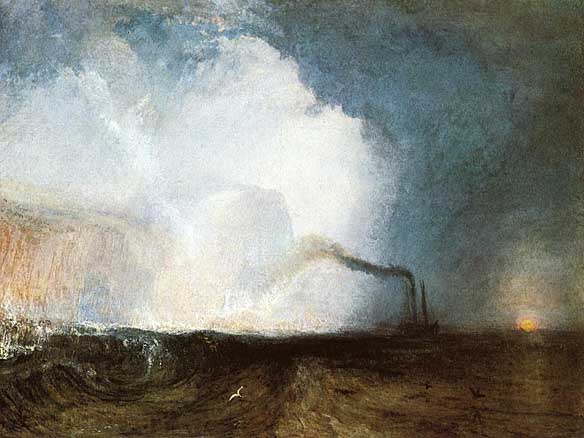
Turner. hoocher.com ''The first American to buy a Turner painting was James Lenox of New York City, a private collector, Lenox wished to own a Turner and in 1845 bought one unseen through an intermediary, his friend C. R. Leslie. From among the paintings Turner had on hand and was willing to sell for £500, Leslie selected and shipped the 1832 atmospheric seascape 'Staffa, Fingal's Cave'. Worried about the painting's reception by Lenox, who knew Turner's work only through his etchings, Leslie wrote Lenox that the quality of Staffa, "a most poetic picture of a steam boat" would become apparent in time. Upon receiving the painting Lenox was baffled, and "greatly disappointed" by what he called the painting's "indistinctness". When Leslie was forced to relay this opinion to Turner, Turner said "You should tell Mr. Lenox that indistinctness is my fault." Staffa, Fingal's Cave is currently owned by the Yale Center for British Art, New Haven, Connecticut.''
”So, self-taught and self-directed, Turner became an almost Dickensian character, smudging his way through society and life. “Me dad never praised me except for the saving of a shilling,” Turner would say, and he became famous for pinching pennies, charging patrons for the cost of their frames (something the better sort of painter threw in as a salute to the carriage trade) and even demanding taxi fare home when he delivered a canvas. He would write down the dates and serial numbers of every banknote he was paid with, and while he kept hordes of cats in his various London homes, they were all tail-less, on the theory that tail-less cats saved money by dragging less of the cold air in with them when they came in from outside.” ( Dan Bischoff )
What kind of man was Turner by this time, fifty years old and at the height of his success? From a portion of the evidence it would be easy to picture him as a solitary misanthrope and certainly it would be wrong to deduce any character in which there was not a strong element of pessimism. His use of human figures, so often the tiny victims of cosmic cataclysms , is frequently given as evidence that Turner was preoccupied with the theme of man’s frailty, the indifference of the Gods or of nature, to our puny fate.
But the comment is never much more than post-scriptural, and the figures themselves, usually ill-drawn, are likewise postscripts to the rest of the painting and rather obtrusive in their small way. As often as not, the figures, with whatever philosophical comment they carry, seem to have been introduced as concessions to the nineteenth-century public’s feeling of unease when faced by a picture without some kind of human or narrative interest to cling to.
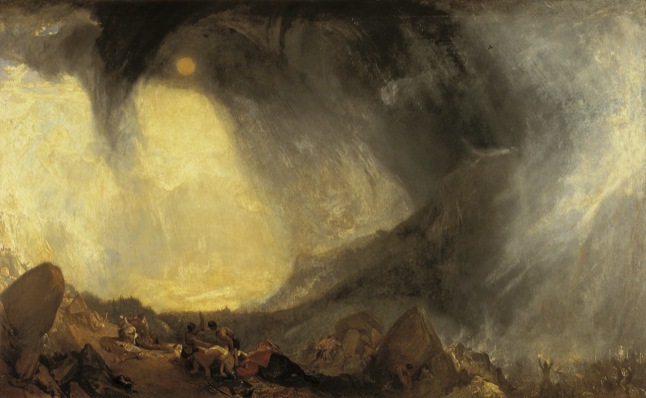
Turner. Hannibal Crossing the Alps. ''Important support for his works also came from Walter Ramsden Fawkes, of Farnley Hall, near Otley in Yorkshire, who became a close friend of the artist. Turner first visited Otley in 1797, aged 22, when commissioned to paint watercolors of the area. He was so attracted to Otley and the surrounding area that he returned time and time again. The stormy backdrop of 'Hannibal Crossing The Alps' is reputed to have been inspired by a storm over Otley's Chevin while Turner was staying at Farnley Hall.''
Perhaps the secretive and aloof Turner gained catharsis through puzzling prose. We are often reminded that his Cockney accent was unacceptable to the average nineteenth century aesthete—such animosity might make the hardiest of souls dumb, including Turner, but what about his ability to release his innermost sensibilities?
“I trembled wak’d, and for a season after
Could not believe, but that I was in hell.
Such terrible impression made my dream.
Or;
“Summer will shed her many blossoms fair
and Shield the trembling strings in noon tide ray
While ever and anon the dulcet air
Will rapturous thrill then sighing sweets decay.
Now, these could either be the confused Turner on a bad day or the lucid Shakespeare on a good one; here it is left to the Shakespeare, or Turner scholar to differentiate. Could these excerpts be leading up to the Fallacies of Hope by Turner, or are they poetic dialogue from Shakespeare? In fact one quote is from Turner’s verse book and one is from Shakespeare’s King Richard the Third. “At times it was difficult to know what Turner meant, but the indistinctness of his thoughts, like the indistictness of his pictures, always indicated either greatness or beauty.”
”If you think blank consternation over the indecipherable smears the rich were paying good money to look at was restricted to the dawn of total abstraction after the 1940s, just listen to how folks once described the work of “J.M.W. Turner,” … In 1841, for example, a popular stage pantomime in London had a boy carrying a tray of jam tarts fall through the skylight of a gallery where Turner was showing. The dealer dusted down the broken tarts, put a frame around them, and offered to sell them for a thousand pounds.
Cue the laughing trombones. Actually, Turner was not the man (as critic John Ruskin said) to fling a “pot of paint in the public’s face,” as even a cursory glance through these 140 oils, watercolors and prints will tell you. For all the talk about how England’s greatest painter, the working class bad boy genius of his day, is a precursor of the Impressionists, he was at heart a man of his age and a Romantic. But he did like a little mystery, making the viewer work to see his theme, which is often reduced to a miniature somewhere you don’t automatically think to look. Even when you do find it, it can still be elusive, largely because the themes themselves can be fugitive.” ( Anthony Venutolo )


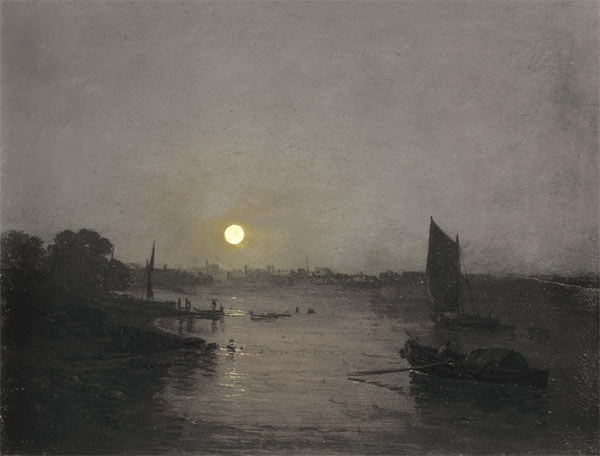
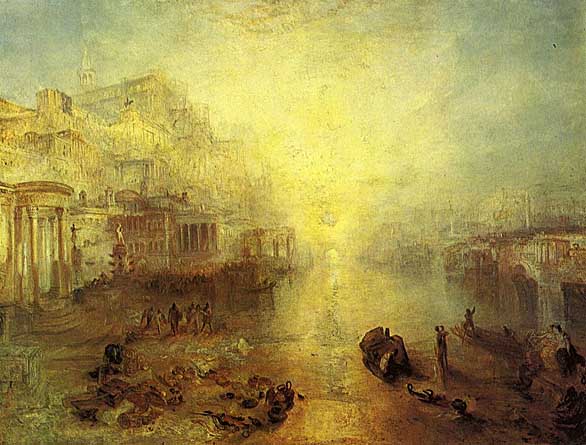



 COMMENTS
COMMENTS